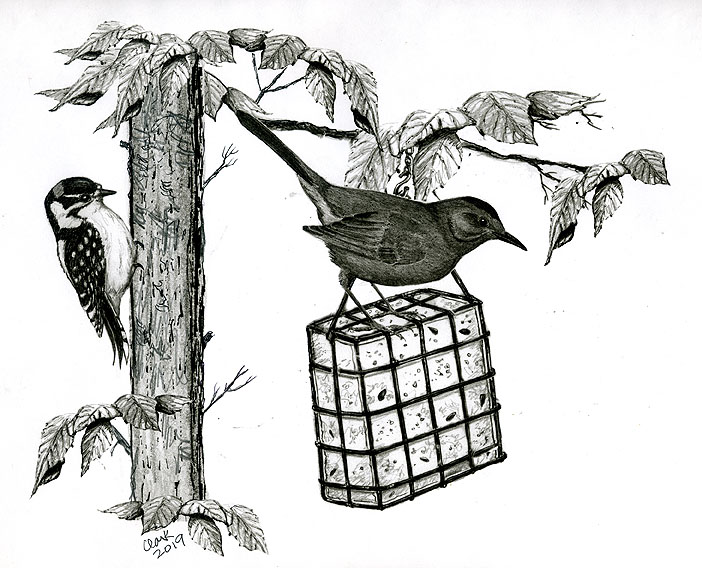
Dear Bird Folks,
I’ve really enjoyed the catbirds in my yard this summer, but I understand they migrate in the fall. When do they leave and where do they go?
– Don, Fitchburg, MA
Soon, Don,
Your catbirds will be leaving soon and they will be the last of my three favorite summer feeder birds to pack up and go. The hummingbirds and orioles have already left, and before long the catbirds will head out as well. Many folks might not even consider catbirds to be a “feeder” bird, but I do. They are friendly, curious and readily come to an assortment of food items and feeders. I like everything about catbirds, except, of course, their name. Talk about being conflicted.
One of the indicators that “my” catbirds are preparing to leave town is a change in their diet. For most of the summer, the catbirds on my feeders have been eating raisins, lots and lots of raisins. I’ve made so many trips to the store to buy raisins that my wife is convinced I’m having an affair with the Sun-Maid Girl. I can see that. She is pretty cute. (FYI: The original Sun-Maid Girl, Lorraine Collett, passed away in 1983, at the age of 100. Maybe we all should start eating more raisins.)
Occasionally, the catbirds would also visit my jelly feeder, but the more aggressive orioles would quickly muscle them out. When the orioles finally left for the year, I thought for sure the catbirds would take over the jelly, but they didn’t. In fact, they lost interest in both the jelly and the raisins (sorry, Sun-Maid Girl). The catbirds in my yard are now spending most of their time eating suet. Why? It appears, at least to me, that they are making an effort to pack on additional fat for their coming migration. It’s been interesting to watch the catbirds move to the suet, although my Downey Woodpecker isn’t happy about it. He doesn’t like to share.
Another sign that the catbirds will be leaving soon is their appearance. Like many songbirds, catbirds go through a complete molt at the end of the summer. Several weeks ago the catbirds looked just plain awful. Instead of being their handsome selves, they were all scraggly and disheveled, looking like something found in a dryer lint basket. But now that the molting process has been completed, the birds are well dressed, dapper and ready to go. Unlike some people I know who fly in sweatpants and T-shirts, catbirds like to look sharp when they travel.
The wintering grounds of Gray Catbirds are fairly widespread. They range from coastal Virginia all the way to Central America. An interesting aspect of their migration is that catbirds from, say, Massachusetts, don’t all spend the winter in the same location. Some birds might only fly to the Carolinas, while others will continue on to Florida or even to an island in the Caribbean (those are the smart ones).
Tracking where birds go in the winter is difficult. A few weeks ago I wrote a column about a Whimbrel (a large shorebird) that had been captured in Wellfleet, where it was outfitted with a satellite transmitter. The transmitter allowed researchers to remotely follow the bird from Wellfleet to South America, where it spent the winter, then on to Canada for the breeding season and back to Wellfleet again. Knowing the bird’s resting and refueling stops helps us better preserve critical habitat. Researchers would also like to know similar information about songbirds, except there’s a problem. Songbirds are small and satellite transmitters are heavy. If they put the Whimbrel’s transmitter on a catbird, the little bird wouldn’t be able to fly. It would have to take a bus to its wintering grounds…and ride along with the sweatpants and T-shirt crowd. There had to be a better way.
Recently, folks from the Smithsonian Migratory Bird Center have been attaching super-light GPS tags to catbirds. The new tags are great at gathering information about a bird’s location, but there’s a drawback. Unlike the Whimbrel’s satellite transmitter, these tiny GPS units don’t broadcast live signals. They only collect info. That means the bird has to be recaptured in order to have its data analyzed. Nevertheless, the information learned so far indicates that catbirds have an assortment of migration strategies. Some birds have sluggish migrations, while others fly more direct, as if they are in a hurry. (They are probably the ones headed to a Caribbean island, and who can blame them?)
The fact that the bird we see is the “Gray” Catbird suggests there must be other catbirds in the world. Yes, there are indeed other catbird species, but they are related in name only. (The common denominator is their distinctive meow call). Africa has the Abyssinian Catbird, Mexico has the Black Catbird and Australia and New Guinea have several species, including the Arfak Catbird. I don’t know anything about that bird, but I wanted to write “arfak” just to make the newspaper’s editor nervous.
The bulk of our catbirds will be leaving within a week or so, Don, but not all of them leave. Last winter I often saw several catbirds in Eastham’s Red Maple Swamp. And since it was a fairly mild winter, the birds probably survived. However, if they stay again this year and we end up having a tougher winter, the results could be different. Instead of giving their sweet “meow” call, these freezing catbirds might be yelling, “arfak.”